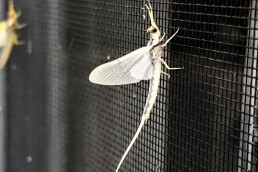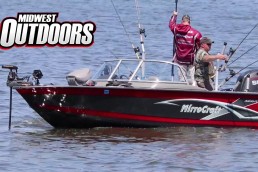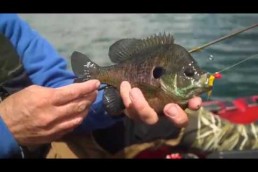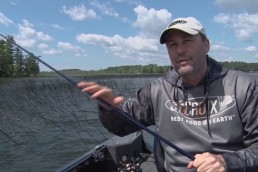Fishing the Shadfly Hatch
SHARE THIS POST
As summer rolls on and we approach July, an annual spectacle of life will occur on the Mississippi River, in the Quad Cities and throughout the Upper Mississippi River Valley. For some people, it is an event that causes awe and wonder. For others, it reminds them that Mother Nature still dominates the landscape, and there will be a mess to clean up.
So many bugs
Mayflies, locally called shadflies, emerge from the Mississippi River substrates to breed on several summer nights each year. This final part of their life cycle requires them to lay eggs in the water just before they expire. A female can lay from several hundred to several thousand eggs. Those eggs will then sink and to the bottom of the river, and adhere to vegetation or other submerged debris in the water. The eggs will hatch in a few weeks, at which point the mayfly will start its nymph stage.
The nymph stage of life will last about a year. During that time, a mayfly (shadfly) nymph will feed on a multitude of items, depending on the species. Densities in the river can be very high, with dozens or even hundreds of mayflies per square foot. Usually, densities of mayflies correlate with the quality of the habitat. The magnitude of the hatch as they emerge from the river becomes clear when the La Crosse, Wisconsin airport radar turns purple, as if the entire area is covered in high-density thunderstorms. A quick Internet search will show the time-lapse photos, which are quite impressive.
Mayflies can come out in such numbers that local municipalities have been known to put out the snowplows to scrape the roads clean of the masses of expired insects. If you live by the river, powerful washers are a must this time of year.
Fishing amongst the mayflies
Angling during the mayfly rush can be difficult, but as always, fish can be caught if you know the conditions and adapt to them. First, if there are trees full of mayflies dying and dropping into the water, expect the fish to be close by (or directly under them). Even larger fish such as walleye will move up on those deeper banks to feed on the mayfly buffet. If you are trying to catch panfish or smaller bass, this can be difficult because the fish are feeding primarily on the mayfly bodies.
Are you enjoying this post?
You can be among the first to get the latest info on where to go, what to use and how to use it!
Since those fish are in an active feeding mode, try to “match the hatch,” similar to what fly fisherman do when different insects emerge on trout streams. If you are fishing evenings and the mayflies are just coming up to the surface, try a very small plastic worm, Senko, fluke, or maybe something that makes a little noise on the surface. A sharp sloped bank with overhanging branches and minimal flow is an ideal spot to fish these techniques. If you are primarily fishing mid-day, small surface lures, flies, or a shallow wax worm presentation can be successful.
My personal favorite for bass fishing during the mayfly craze is an old balsam wood Smithwick devil horse, because it has two spinners that make a lot of noise. In addition, the lure can be flipped in very tight to shore and “ripped” back out. Reaction strikes can be violent, and a lot of fun. Flipping a weightless Senko on braid for any missed strikes is a proven backup plan when a fish is too full to get the devil horse cleanly. Walleyes might hit ringworms and other plastics too, but typically they will be a little deeper out.
This can also be an appropriate time to try a little fly-fishing on the muddy Mississippi. I know a couple guys that fly fish for both bluegills and mooneye when the hatches are in progress. While this technique is used more often on local farm ponds and lakes, it can also be effective on the river (especially while fishing for panfish) during these conditions.
While the shadfly hatch can be an annoyance to people who live along the river, it is a vital part of a healthy ecosystem. Take advantage of these unique fishing opportunities, and enjoy the potentially exciting fishing that can come with it.
MWO
SHARE THIS POST
Did you enjoy this post?
You can be among the first to get the latest info on where to go, what to use and how to use it!
Jeremiah Haas
As a full-time fisheries biologist on the Mississippi River, Jeremiah Haas is intimately tied to the outdoor resources surrounding the greater Quad Cities area and the Upper Mississippi River Basin. An accomplished hunter, fisherman and writer, Haas offers unique insight and perspective to MidWest Outdoors readers.



